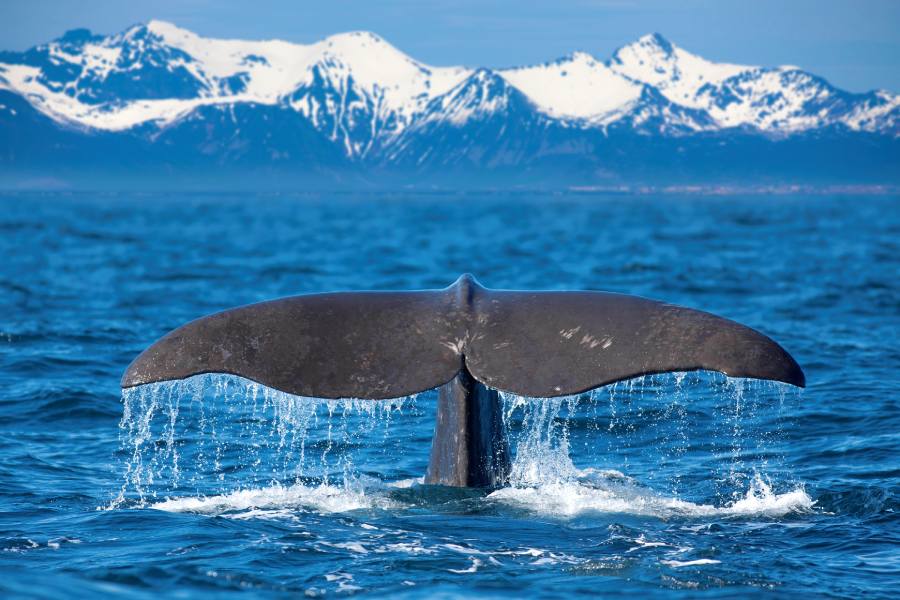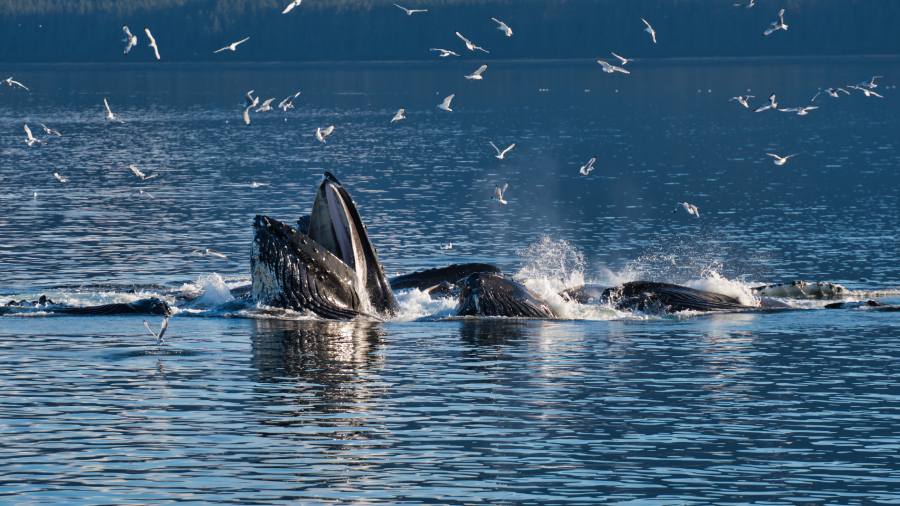Awesome Whale Watching In Alaska
Download Travel Details >PRIVATE & SMALL GROUP TOURS TO THE WORLD'S BEST DESTINATIONS
Three Amazing Alaskan Vacations To Choose From!

Is Alaska A Good Place To See Whales?
If whale watching is on your bucket list, whale watching in Alaska is the vacation for you! The state’s vast wilderness is surrounded on three sides by water, from the North Pacific Ocean along the Inside Passage and Gulf of Alaska, around the Aleutian Islands to the Bering Sea, and up to the Arctic Ocean. More than a dozen species of whales can be seen in this vast range of coastal and marine ecosystems. From an Alaska whale watching cruise to a kayak adventure, there are plenty of ways to see whales in Alaska!

The Best Time To See Whales In Alaska
When is the best time to see whales in Alaska? Every spring, thousands of humpback whales and gray whales travel from the warm waters of Hawaii and Mexico to spend the summer months feeding in Alaska’s nutrient-rich waters. This makes whale watching in Alaska a prime summertime activity! Other species of whales, like orca whales, call Alaska’s waterways home all year long.
In general, summer is the best time to go whale watching in Alaska. Gray whales are the first to arrive in April, and can be spotted off the coast of Seward. By May, orcas become more active and in June the humpback whales begin to arrive. Alaska's peak whale season runs from May through September, which also coincides with cruise season. One of the best ways to see these magnificent creatures is to take an Alaska whale watching cruise!
Where Can You See Whales In Alaska?
Whales can be seen throughout Alaska’s coastal waters - from the Gulf of Alaska in the south, to the eastern Bering Sea and northern Beaufort Sea near the Arctic Ocean. This is especially true during the prime summer season, when the migrating schools swell Alaska’s year-round whale population.
One of the most reliable spots for successful whale watching is Resurrection Bay in Kenai Fjords National Park, off the coast of Seward. Whether you take an Alaska whale watching cruise or paddle through the bay by kayak, you are sure to see whales in Resurrection Bay! The area is also home to otters, harbor seals, Stellar sea lions, bears, puffins, and bald eagles, making it a perfect place for wildlife enthusiasts to see Alaska’s native animals in their natural habitat.
Learning More About Alaska’s Whale Species
 Alaska is home to several whale species, which either inhabit or migrate through its coastal waters. In the Kenai Fjords National Park region, Humpback, orca (killer whale), fin whale, and gray whale are the most commonly sighted species. However, if you look carefully, blue, sperm, and minke whales can also be found in the waters off Alaska’s shores.
Alaska is home to several whale species, which either inhabit or migrate through its coastal waters. In the Kenai Fjords National Park region, Humpback, orca (killer whale), fin whale, and gray whale are the most commonly sighted species. However, if you look carefully, blue, sperm, and minke whales can also be found in the waters off Alaska’s shores.
The top three most commonly sighted Alaska whales are listed below:
- Humpback whales – humpback whales are one of the most commonly seen species in Alaska. The flukes, or tails, of humpback whales have distinct patterns that make it possible to identify individual whales. The most impressive humpback sightings involve breaching, when whales leap out of the water, and bubble net feeding, where groups of whales work together to release columns of bubbles to trap small fish and krill and then open their giant mouths at the surface of the water to capture their meal. The best time to view humpback whales in Alaska is May through September after the whales have migrated to Alaska to feed on plankton and krill in the state’s nutrient-rich waters. The best viewing opportunities for humpback whales are in the waters outside of Juneau, Sitka, and other Inside Passage communities, Kenai Fjords National Park, Prince William Sound, the waters around Kodiak Island and the Barren Islands, and the eastern Aleutian Islands.
- Orca whales – Orca whales, also known as killer whales, are a member of the dolphin family. Intelligent and highly social, they are distinguished by their dorsal fins that can grow up to six feet tall. Orcas travel in pods of up to about 40 animals and have a complex matrilineal social structure led by the elder female of the pod. There are three different types of orcas in Alaska, based on their prey and habitat: resident, transient, and offshore. Resident orcas feed only on fish and tend to stay near coastal areas, while transient orcas feed on marine mammals like seals, porpoises, and sea lions and have a larger range. Offshore orcas are elusive and are found primarily in the open ocean, feeding on sharks and fish. The best places to see orcas in Alaska are the waters outside of Juneau and other Inside Passage communities, Kenai Fjords National Park, Prince William Sound, Kachemak Bay State Park, the waters around Kodiak Island, and the Aleutian Islands.
- Gray whales - Gray whales are the first migrating whales to reach Alaska each spring. Swimming slowly from their winter breeding grounds in Mexico’s Baja California, gray whales have one of the longest migrations of any mammal on earth — up to 14,000 miles round trip! They spend their summers feeding in Alaska’s Bering, Chukchi, and Beaufort Seas before heading back down to warmer waters in the fall. The best areas to see gray whales in Alaska are their migration route, before and after they reach their northern feeding grounds. You may see gray whales heading north along Inside Passage and Southcentral waters from mid-March to April, with the best viewing opportunities in Sitka, Seward, and Kodiak.
Let’s Go On An Alaska Whale Watching Cruise
One of the best ways to see Alaska whales is to go on an Alaska whale watching cruise. The most popular way to view whales is aboard a whale-watching day cruise or charter from coastal communities in the Southcentral, Inside Passage, and Southwest regions. Whale-watching day cruises range from half-day to full-day. You can charter a small boat that only holds a handful of passengers or book a trip on a large catamaran that seas hundreds of tourists. But no matter what option you choose, Alaska’s pristine and icy waters are the perfect place to see these magnificent creatures in their native habitat!


